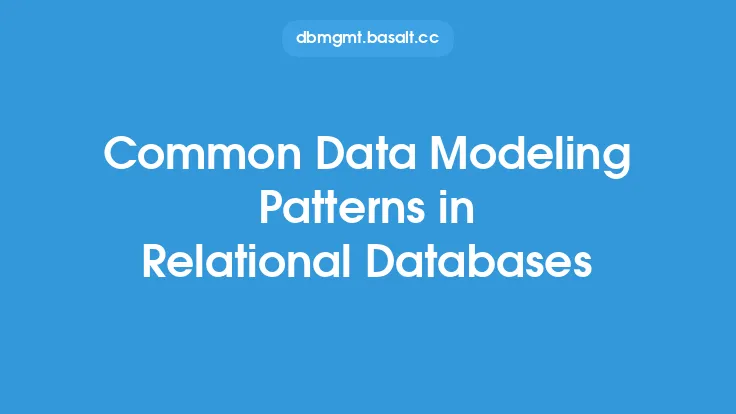Data redundancy is a common issue in data modeling that can lead to inconsistencies, errors, and inefficiencies in data storage and retrieval. It occurs when the same data is stored in multiple locations, making it difficult to maintain data integrity and ensure that all instances of the data are updated simultaneously. In this article, we will explore the concept of data redundancy, its causes, and most importantly, the best practices for avoiding it in data modeling.
Introduction to Data Redundancy
Data redundancy can be defined as the duplication of data in a database or data storage system. This can happen in various forms, such as storing the same data in multiple tables, columns, or even databases. Data redundancy can lead to a range of problems, including data inconsistencies, errors, and increased storage requirements. For instance, if a customer's address is stored in multiple tables, updating the address in one table may not automatically update it in the other tables, leading to inconsistencies and potential errors.
Causes of Data Redundancy
There are several causes of data redundancy in data modeling. One of the primary causes is poor data design, where the data model is not properly normalized, leading to data duplication. Another cause is the lack of standardization in data storage, where different tables or databases may store the same data in different formats or structures. Additionally, data redundancy can also occur due to the integration of multiple data sources, where the same data may be stored in different systems or databases.
Normalization Techniques
Normalization is a fundamental concept in data modeling that helps to eliminate data redundancy. Normalization involves organizing data into tables and columns in a way that minimizes data duplication and ensures that each piece of data is stored in one place and one place only. There are several normalization techniques, including first normal form (1NF), second normal form (2NF), and third normal form (3NF). Each normalization technique helps to eliminate data redundancy by ensuring that each table has a unique set of columns and that each column contains only atomic values.
Entity-Relationship Modeling
Entity-relationship modeling is a powerful technique for avoiding data redundancy in data modeling. This technique involves identifying entities, attributes, and relationships between them. By modeling the relationships between entities, data redundancy can be eliminated, and data consistency can be ensured. For instance, if a customer has multiple orders, the customer entity can be related to the order entity, eliminating the need to store the customer's data in multiple tables.
Data Warehousing and Star Schemas
Data warehousing and star schemas are also effective techniques for avoiding data redundancy. A data warehouse is a centralized repository that stores data from multiple sources, eliminating the need for data duplication. A star schema is a data modeling technique that involves organizing data into a central fact table surrounded by dimension tables. This technique helps to eliminate data redundancy by storing each piece of data in one place and providing a single source of truth for the data.
Best Practices for Avoiding Data Redundancy
To avoid data redundancy in data modeling, several best practices can be followed. First, it is essential to normalize the data model to ensure that each piece of data is stored in one place and one place only. Second, entity-relationship modeling can be used to identify entities, attributes, and relationships between them, eliminating data redundancy. Third, data warehousing and star schemas can be used to store data from multiple sources in a centralized repository, eliminating data duplication. Finally, data standardization and data governance can be implemented to ensure that data is stored in a consistent and standardized format across the organization.
Tools and Technologies for Avoiding Data Redundancy
Several tools and technologies can be used to avoid data redundancy in data modeling. Data modeling tools, such as entity-relationship diagrams and data flow diagrams, can be used to design and implement data models that eliminate data redundancy. Data warehousing tools, such as ETL (extract, transform, load) tools, can be used to integrate data from multiple sources and store it in a centralized repository. Additionally, data governance tools, such as data quality and data validation tools, can be used to ensure that data is accurate, complete, and consistent across the organization.
Conclusion
Data redundancy is a common issue in data modeling that can lead to inconsistencies, errors, and inefficiencies in data storage and retrieval. By understanding the causes of data redundancy and implementing best practices, such as normalization, entity-relationship modeling, data warehousing, and data governance, data redundancy can be eliminated, and data consistency can be ensured. Additionally, tools and technologies, such as data modeling tools, data warehousing tools, and data governance tools, can be used to support the implementation of these best practices and ensure that data is accurate, complete, and consistent across the organization. By following these best practices and using these tools and technologies, organizations can ensure that their data is well-organized, efficient, and effective, leading to better decision-making and improved business outcomes.





